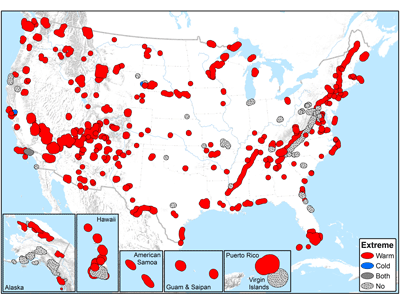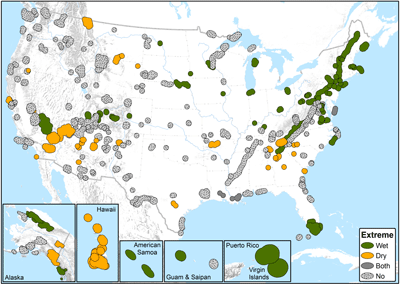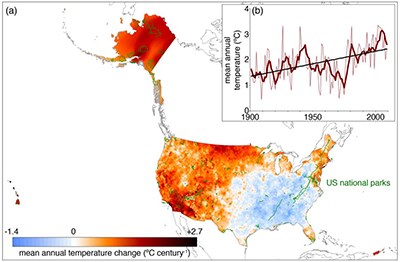Climate Exposure of U.S. National Parks
An overwhelming majority of parks are already at the extreme warm end of their historical conditions. That is a core finding of published research by NPS scientists providing basic climate inventories for 289 national park units.

Open the panel below to download individual briefs for each park in this project, or continue reading for study highlights.
Source: Data Store Collection 5502. To search for additional information, visit the Data Store.

- 235 of 289 parks (81%) were categorized as “extreme warm”, 2 parks (1%) as “extreme cold,” 1 park (<1%) was both “extreme warm and cold,” and 51 parks (17%) did not have any recent extreme temperature variables.
- The two most common extreme warm variables for parks were mean temperature of the warmest quarter (170 parks, 59%) and annual mean temperature (158 parks, 55%).
Results for “extreme” precipitation:
- 78 parks (27%) were “extreme wet,” 43 parks (15%) were “extreme dry," 2 parks (2%) were both “extreme wet and dry,” and 166 parks (57%) did not have any recent extreme precipitation variables.
- The most common extreme wet variables were annual precipitation (44 parks, 15%) and precipitation of the wettest quarter (44 parks, 15%), while the most common extreme dry variables were precipitation of the driest quarter (17 parks, 6%) and wettest quarter (16 parks, 6%).
These results show how recent climatic conditions are already shifting beyond the historical range of variability at many parks. Ongoing and future climate change will likely affect all aspects of park management, including natural and cultural resource protection, park operations and visitor experience. Research such as this can help parks develop effective management plans grounded in comprehension of past dynamics, present conditions, and projected future change.
The findings from this research can also inform climate change adaptation by helping park managers, planners, and interpreters to understand how recent climates compare to past conditions. For example, these findings may be used to characterize park exposure to recent climate change in a vulnerability assessment; develop plausible and divergent futures for use in a climate change scenario planning workshop; and synthesize desired future conditions (i.e., reference conditions) for use management plans.
The findings from this research can also inform climate change adaptation by helping park managers, planners, and interpreters to understand how recent climates compare to past conditions. For example, these findings may be used to characterize park exposure to recent climate change in a vulnerability assessment; develop plausible and divergent futures for use in a climate change scenario planning workshop; and synthesize desired future conditions (i.e., reference conditions) for use management plans.

Gonzalez et al. 2018
Disproportionate Warming of the
National Park System
Recent work demostrates the impact of human-caused climate change to parks. Since 1895, the U.S. National Park System has seen greater increases in heat and aridity than the country as a whole. This is because extensive areas of the National Park System are located in extreme environments in Alaska and the American West.
Continued carbon emissions will bring higher temperatures to the National Park System over the next century. But reducing emissions from cars, power plants, and other human sources can help. Doing so would reduce the projected temperature increases by one-third to one-half.
Last updated: March 1, 2022
